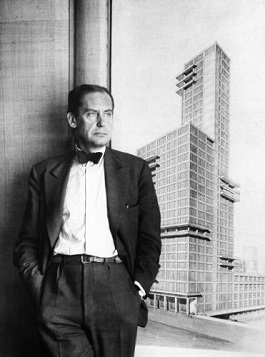
One hundred years of Bauhaus - a significant school of architecture and design
 |
The environment of the Bauhaus was renowned for its creative liberalism and progressiveness. The school included students from abroad as well as a number of women. In addition to architecture, subjects such as metalworking, textiles, photography, typography, and scenography were taught here. Students first had to learn a trade in one of the fields, and later began working under the guidance of leading artists of the time. The goal was for Bauhaus graduates to master their craft and various disciplines, thus becoming well-rounded artists.
Notable figures associated with the school included architects (and three directors of the Bauhaus) Walter Gropius, Hannes Meyer, and Ludwig Mies van der Rohe, as well as artists such as Wassily Kandinsky, Paul Klee, Piet Mondrian, Lyonel Feininger, Josef Albers, László Moholy-Nagy, and Oskar Schlemmer. From the Czech representatives, art theorist and artist Karel Teige lectured in Dessau. The influence of the Bauhaus is evident in the buildings of architects Jaromír Krejcar and Bohuslav Fuchs.
The Bauhaus was founded in 1919 by Gropius, who built upon the art and design school of architect Henry van de Velde. "Young and angry" creators, advocating simplicity, geometry, and function after the era of ornate Art Nouveau, appeared as revelations at the time. In 1925, the Bauhaus moved to Dessau due to political pressure. The complex of buildings there - classrooms, workshops, dormitories, and the so-called Masters' Houses - is now on UNESCO's list of World Heritage sites.
In Berlin, the school operated in 1932 and 1933. After the rise of the Nazis, who deemed the Bauhaus style too "Jewish-Marxist", the institution was closed. However, its ideas persisted in the educational methods adopted by many universities. Mies and Gropius later moved to the USA, where they continued to pursue their careers. "The Bauhaus profoundly influenced me. Not only with its minimalism and functional aesthetics but also with its sense of humor," said Steve Jobs, founder of Apple, for example.
Buildings based on Bauhaus principles can also be found in Tel Aviv, Israel, where an entire complex of houses (the so-called White City) was created, which is protected by UNESCO. In the 1930s, it was built by Jewish architects who fled from Germany in the face of the Nazi threat. Some of them were Bauhaus students or were influenced by it. Buildings in this style can also be found in Japan, China, and the Czech Republic. An example is the Tugendhat Villa in Brno (1929 to 1930), designed by Mies van der Rohe.
Selection of personalities associated with the Bauhaus:
- Walter Gropius (1883 to 1969) - German architect, urban planner, and theorist. He was the first director of the Bauhaus, whose creation he initiated. In 1928, he resigned due to exhaustion and attacks on himself. After the Nazis came to power, he emigrated to England in 1934 and three years later accepted a professorship at Harvard University in the USA.
- Mies van der Rohe (1886 to 1969) - German architect and designer, director of the Bauhaus. He took over the management of the school in 1930 when the clouds were beginning to gather over German modernism. In 1934, he was barred from working, and four years later he fled to the USA from the Nazis. He is also the author of the Tugendhat Villa in Brno, a UNESCO monument.
- Wassily Kandinsky (1866 to 1944) - Russian painter and theorist, one of the founders of abstract art, professor at the Bauhaus. A graduate in law and economics, he chose to become a painter at the age of 30. After the rise of the Nazis and the closure of the Bauhaus, he moved to France in 1933.
- Paul Klee (1879 to 1940) - Swiss painter and graphic artist, professor at the Bauhaus from 1921 to 1933. His works were also labeled as "degenerate art" and removed from collections and museums after the Nazis came to power.
- Marcel Breuer (1902 to 1981) - architect and furniture designer of Hungarian descent, a graduate of the Bauhaus. He worked in Germany and the USA, and taught at Harvard University. He was a pioneer of tubular furniture, known for the Wassily chair.
- László Moholy-Nagy (1895 to 1946) - Hungarian painter, avant-garde photographer, and professor at the Bauhaus. A law graduate, he experimented with composition, color, and light as an artist. He later worked in London and Chicago, where he established his own design school.
- Oskar Schlemmer (1888 to 1943) - German painter and sculptor who led the scenography workshop at the Bauhaus. He created scenographies for ballets, introducing revolutionary concepts, where, for example, the costumes of the performers turned them into living sculptures that formed part of the scene.
The English translation is powered by AI tool. Switch to Czech to view the original text source.
0 comments
add comment
Related articles
0
03.01.2025 | The year 2025 will be the year of Bauhaus in German Dessau, celebrating its centenary
0
06.04.2019 | A new Bauhaus museum was ceremoniously opened in Weimar
0
18.03.2019 | Architecture lovers can live like Bauhaus students once did
0
16.01.2019 | In Germany, the celebrations for the 100th anniversary of the founding of the Bauhaus are beginning
0
03.12.2016 | 90 years ago, the Bauhaus, a famous design school, was opened in Dessau
0
02.04.2009 | Germany is celebrating the 90th anniversary of the founding of the Bauhaus











